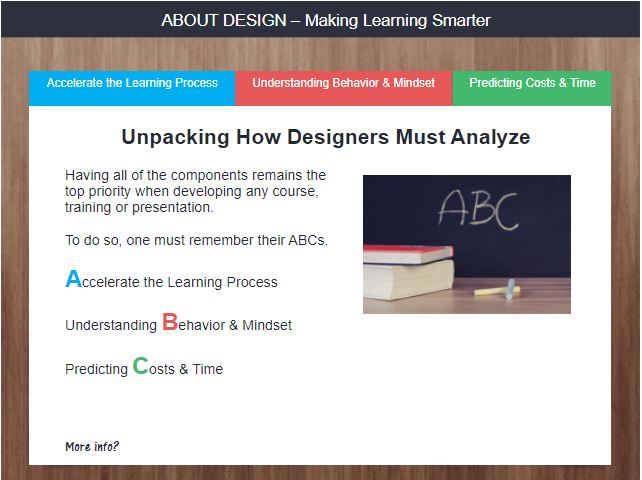Before I share about what I’ve discovered, I’d like to take a moment to celebrate those who share and instructional designers and models that have made significant contributions.
You have raised my awareness about so many new things and to that I am humbled. The work you do compels me to share more now than ever.
This week’s blog starts the first of several blogs that shows a more comprehensive approach to instructional design to which I’ve named ABOUT DESIGN.
Today we discuss the importance of why we must analyze every aspect of instructional design from start to finish.
Analyze The Difference Between The Academic and Corporate World
Those who champion their work often take time to reflect on their performance. They attend professional development, workshops, conferences and network with others across the globe so their projects are flawless.
Our work depends on factors like one’s pedagogy, and beliefs.
However, after reviewing people’s styles, I found numerous similarities.
You might even say I conducted a crosswalk of sorts, or cross referenced the learning outcomes of the courses to standards, employability, and 21st Century skills.
Conceptualizing the process, think about a Venn Diagram where the overlap contains what Instructional Designers and Educators use regularly.
Click on the tabs below and you will see that when we analyze, it’s as simple as reciting our ABC’s.
What model do educators and Instructional Designers use in common?
Through this quest, many concepts overlapped.
- Blooms – Educators are moving towards the digital taxonomy while Instructional Designers mostly use the traditional taxonomy.
- Understanding By Design (UBD)
- Identify desired results, determine acceptable evidence, plan learning experiences & instruction
- SAM (Success Approximation Model)
- Prepare, Develop, Design
What each group doesn’t have?
And there were justifiable reasons each group didn’t have what the other did in their toolbox.
Instructional Designers do not consistently integrate Socio Emotional Learning (SEL) factors. SEL plays a vital part in the ways both adults and adolescents learn. If someone is not in the frame of mind to learn, information will not sink in. No matter how well the course is designed, how engaging it is, the information becomes a moot point should the user have distractions going on in the background.
Educators graduate from college with the theory but often struggle with applying real world situations in their lessons. Another major factor denoted comes from the lack of time and resources needed to prepare and deliver the perfect lesson. Educators constantly focus on gap analysis but struggle to develop well-rooted skill development because of time.
Disclaimer – Please note that I want to raise awareness for everyone to see each other’s perspective rather than bash or make implications.
How do Instructional Designers Analyze better?
Recognize the old expression, “you don’t know to ask because you don’t know.”
To remove the barrier, questions similar to those below should be considered early in developing the project.
- What are our client’s needs?
- Who will the course be designed for and why?
- Do you have a list of goals for the course?
- What gap analysis have you done to ensure that the goals of the course are what is needed?
- What should a typical lesson include? (Must haves from the client)
- What’s the time for a typical lesson?
- Can you share the timeline in which you want the final product)?
- Please share the budget for the project?
- What expenditures must we incur?
- If something is needed are we able for reimbursement?
- Share with us what kind of assessments you want the user to have in the course?
- Are you open minded to other types of assessments?
- How does the client want users engaged?
- How does the client see the user engaged?
- What required resources or standards should we include?
- Are there any industry standards? must reference?
- Can SMEs guide the ID on subject matter?
- Is this course required for annual Training?
- If so, what updates must we include or toss out?
- What outside factors must ID consider? Example – Top secret clearance, NDA, privacy Act from any data collection
- What tech configurations should we know ahead of time?
- What LMS host should we build for the course?
- Are there any –tech constraints such as band width speed, size of files or otherwise?
- How many users will participate at one time? Asynchronous, Hybrid or in-person course)
- What kind of technology should ID expect a typical user to use when taking the course!
- What specific software must be included or referenced in the course?
- Are there incentives for the user who completes the course?
- What must users do differently should they fail or complete the course in its entirety?
Considering these factors lays the foundation for a better in-depth analysis of understanding the needs and what the outcomes should look like when it’s completed.
What’s missing? I’d love to know what you think?
Comment below or contact me for more information.
Thank you Ms. Montse Anderson for the template!


Leave a Reply
You must be logged in to post a comment.